TOYOTA TUNDRA 2015 2.G Owners Manual
Manufacturer: TOYOTA, Model Year: 2015, Model line: TUNDRA, Model: TOYOTA TUNDRA 2015 2.GPages: 576, PDF Size: 9.71 MB
Page 201 of 576
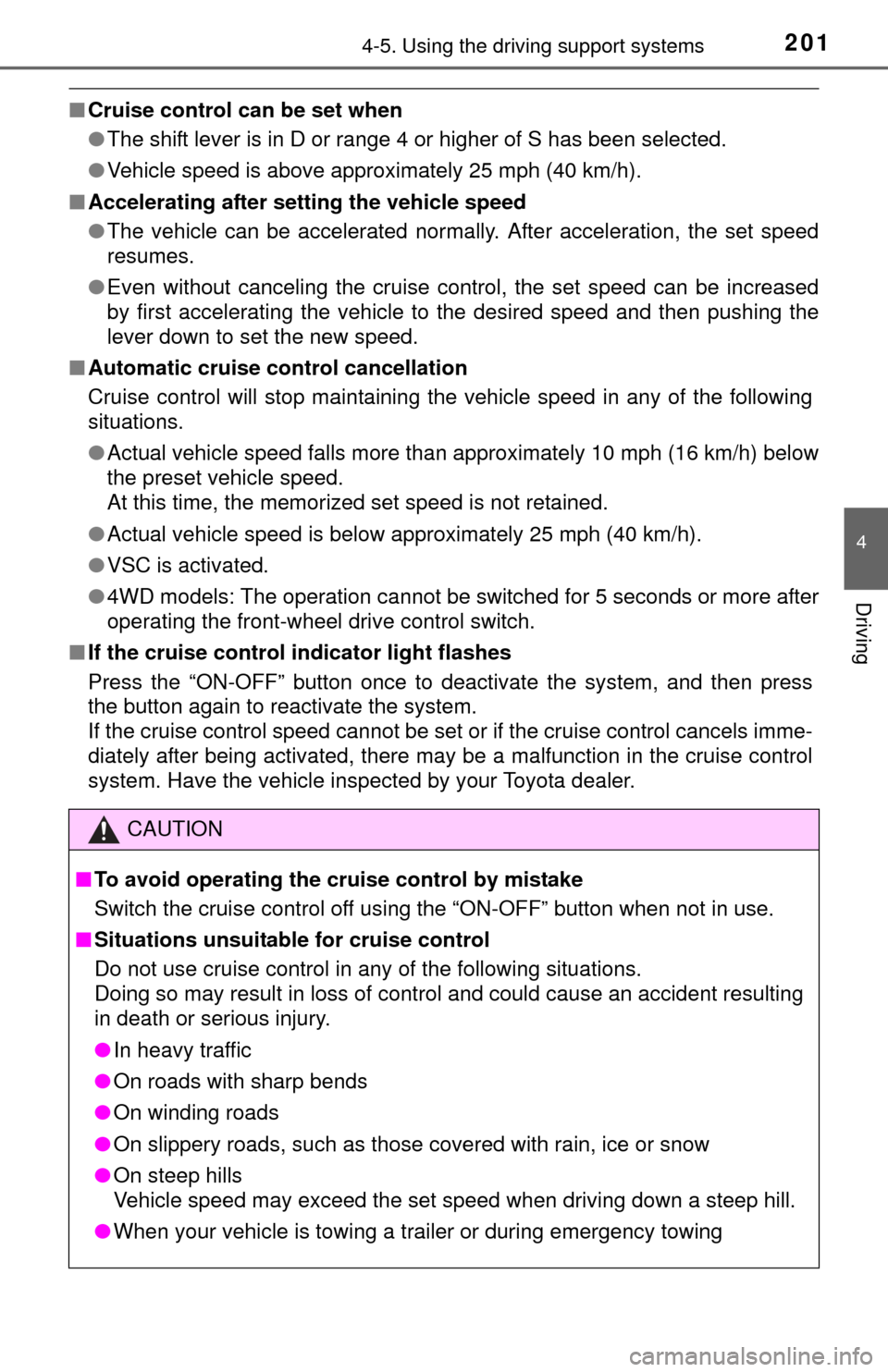
2014-5. Using the driving support systems
4
Driving
ÔûáCruise control can be set when
ÔùÅThe shift lever is in D or range 4 or higher of S has been selected.
ÔùÅ Vehicle speed is above approximately 25 mph (40 km/h).
Ôûá Accelerating after setting the vehicle speed
ÔùÅThe vehicle can be accelerated normally. After acceleration, the set speed
resumes.
ÔùÅ Even without canceling the cruise control, the set speed can be increased
by first accelerating the vehicle to the desired speed and then pushing the
lever down to set the new speed.
Ôûá Automatic cruise control cancellation
Cruise control will stop maintaining the vehicle speed in any of the following
situations.
ÔùÅActual vehicle speed falls more than approximately 10 mph (16 km/h) below
the preset vehicle speed.
At this time, the memorized set speed is not retained.
ÔùÅ Actual vehicle speed is below approximately 25 mph (40 km/h).
ÔùÅ VSC is activated.
ÔùÅ 4WD models: The operation cannot be switched for 5 seconds or more after
operating the front-wheel drive control switch.
Ôûá If the cruise control indicator light flashes
Press the ÔÇ£ON-OFFÔÇØ button once to deactivate the system, and then press
the button again to reactivate the system.
If the cruise control speed cannot be set or if the cruise control cancels imme-
diately after being activated, there may be a malfunction in the cruise control
system. Have the vehicle inspected by your Toyota dealer.
CAUTION
ÔûáTo avoid operating the cruise control by mistake
Switch the cruise control off using the ÔÇ£ON-OFFÔÇØ button when not in use.
Ôûá Situations unsuitable for cruise control
Do not use cruise control in any of the following situations.
Doing so may result in loss of control and could cause an accident resulting
in death or serious injury.
ÔùÅ In heavy traffic
ÔùÅ On roads with sharp bends
ÔùÅ On winding roads
ÔùÅ On slippery roads, such as those covered with rain, ice or snow
ÔùÅ On steep hills
Vehicle speed may exceed the set speed when driving down a steep hill.
ÔùÅ When your vehicle is towing a trailer or during emergency towing
Page 202 of 576
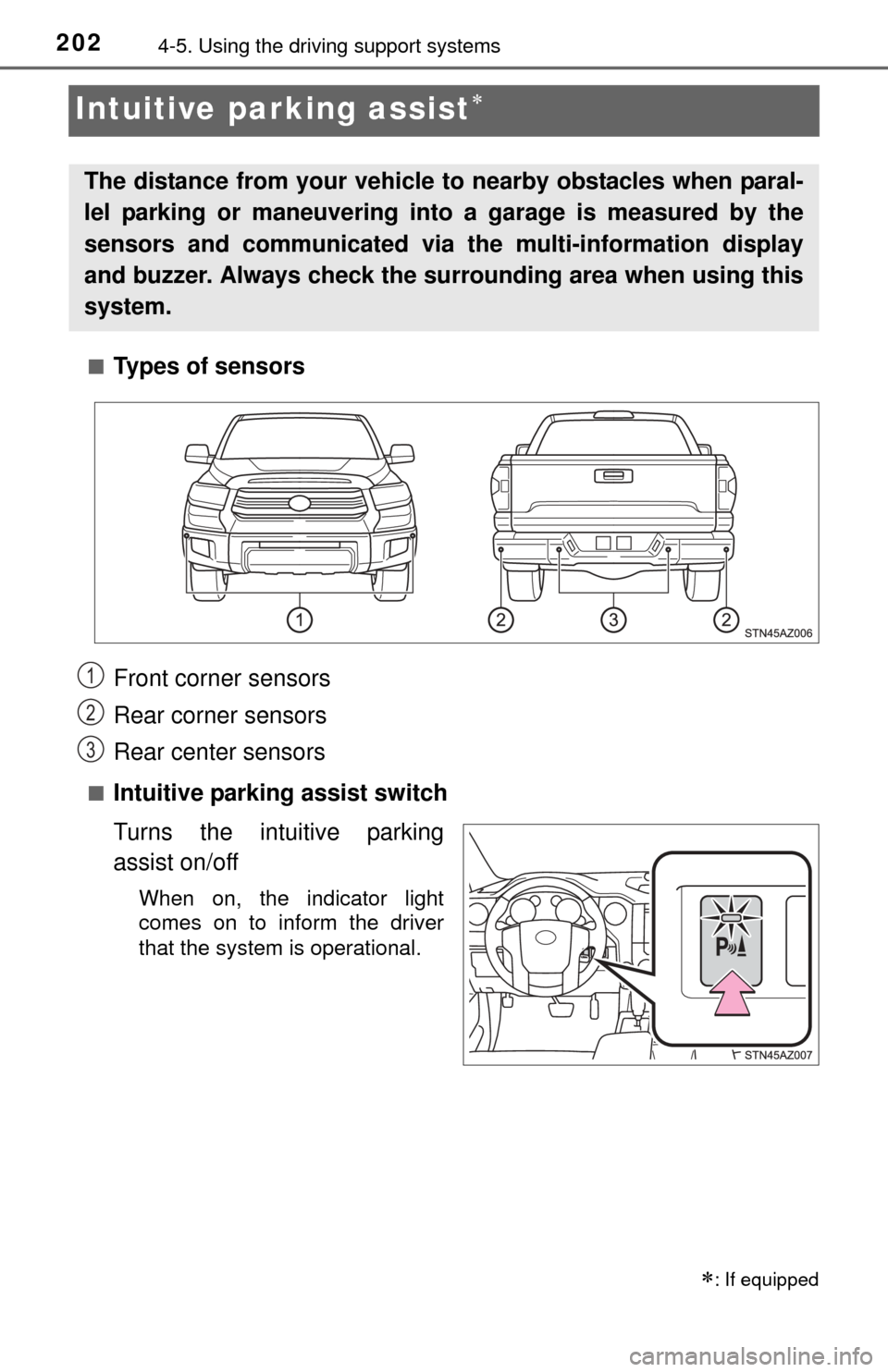
2024-5. Using the driving support systems
Intuitive parking assist´Ç¬
ÔûáTypes of sensors
ÔûáIntuitive parking assist switch
Turns the intuitive parking
assist on/off
When on, the indicator light
comes on to inform the driver
that the system is operational.
´Ç¬: If equipped
The distance from your vehicle to nearby obstacles when paral-
lel parking or maneuvering into a garage is measured by the
sensors and communicated via the multi-information display
and buzzer. Always check the su rrounding area when using this
system.
Front corner sensors
Rear corner sensors
Rear center sensors1
2
3
Page 203 of 576
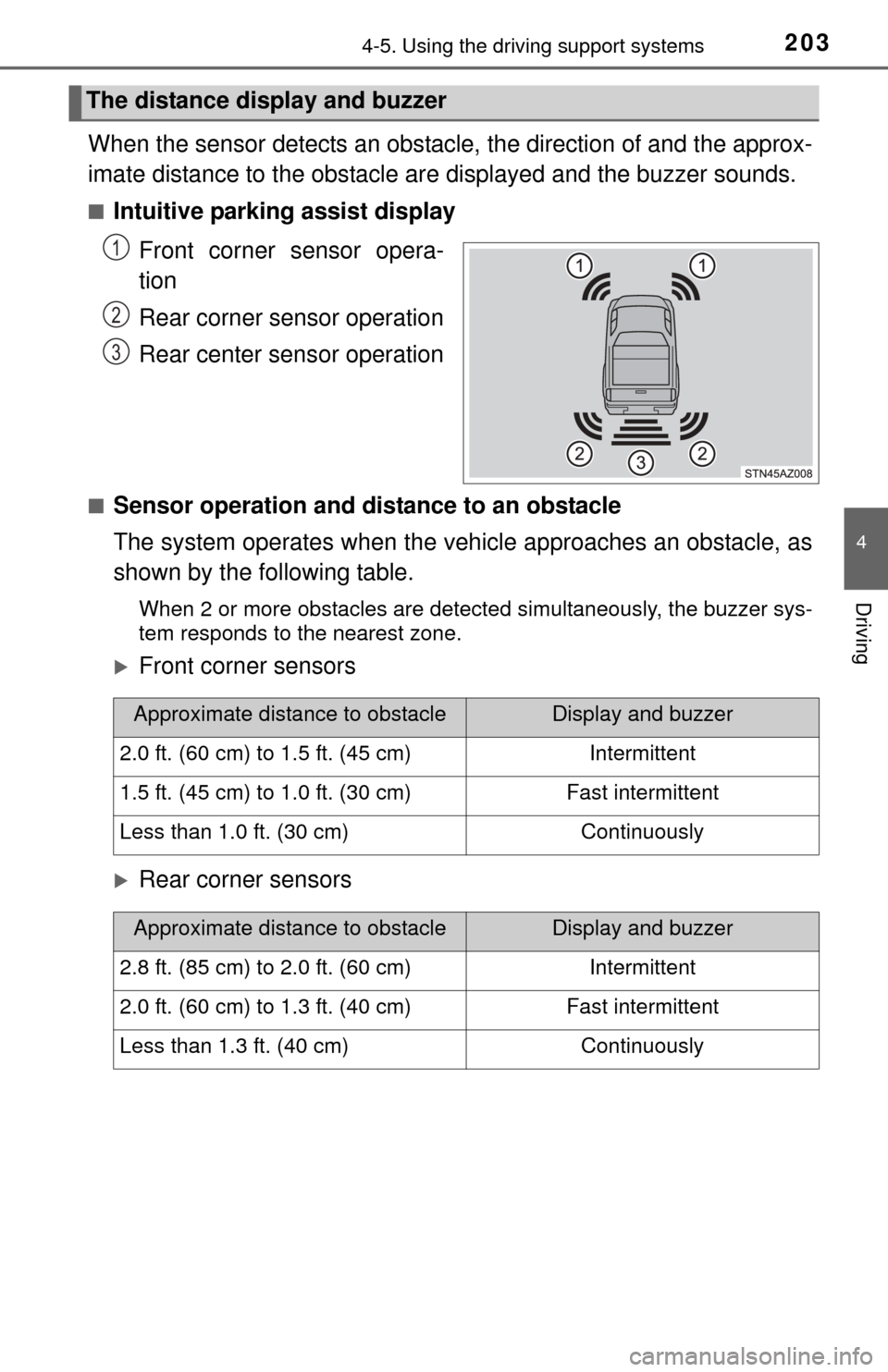
2034-5. Using the driving support systems
4
Driving
When the sensor detects an obstacle, the direction of and the approx-
imate distance to the obstacle ar e displayed and the buzzer sounds.
ÔûáIntuitive parking assist display
Front corner sensor opera-
tion
Rear corner sensor operation
Rear center sensor operation
ÔûáSensor operation and distance to an obstacle
The system operates when the vehicle approaches an obstacle, as
shown by the following table.
When 2 or more obstacles are detected simultaneously, the buzzer sys-
tem responds to the nearest zone.
´üÁFront corner sensors
´üÁRear corner sensors
The distance display and buzzer
1
2
3
Approximate distance to obstacleDisplay and buzzer
2.0 ft. (60 cm) to 1.5 ft. (45 cm)Intermittent
1.5 ft. (45 cm) to 1.0 ft. (30 cm)Fast intermittent
Less than 1.0 ft. (30 cm)Continuously
Approximate distance to obstacleDisplay and buzzer
2.8 ft. (85 cm) to 2.0 ft. (60 cm)Intermittent
2.0 ft. (60 cm) to 1.3 ft. (40 cm)Fast intermittent
Less than 1.3 ft. (40 cm)Continuously
Page 204 of 576
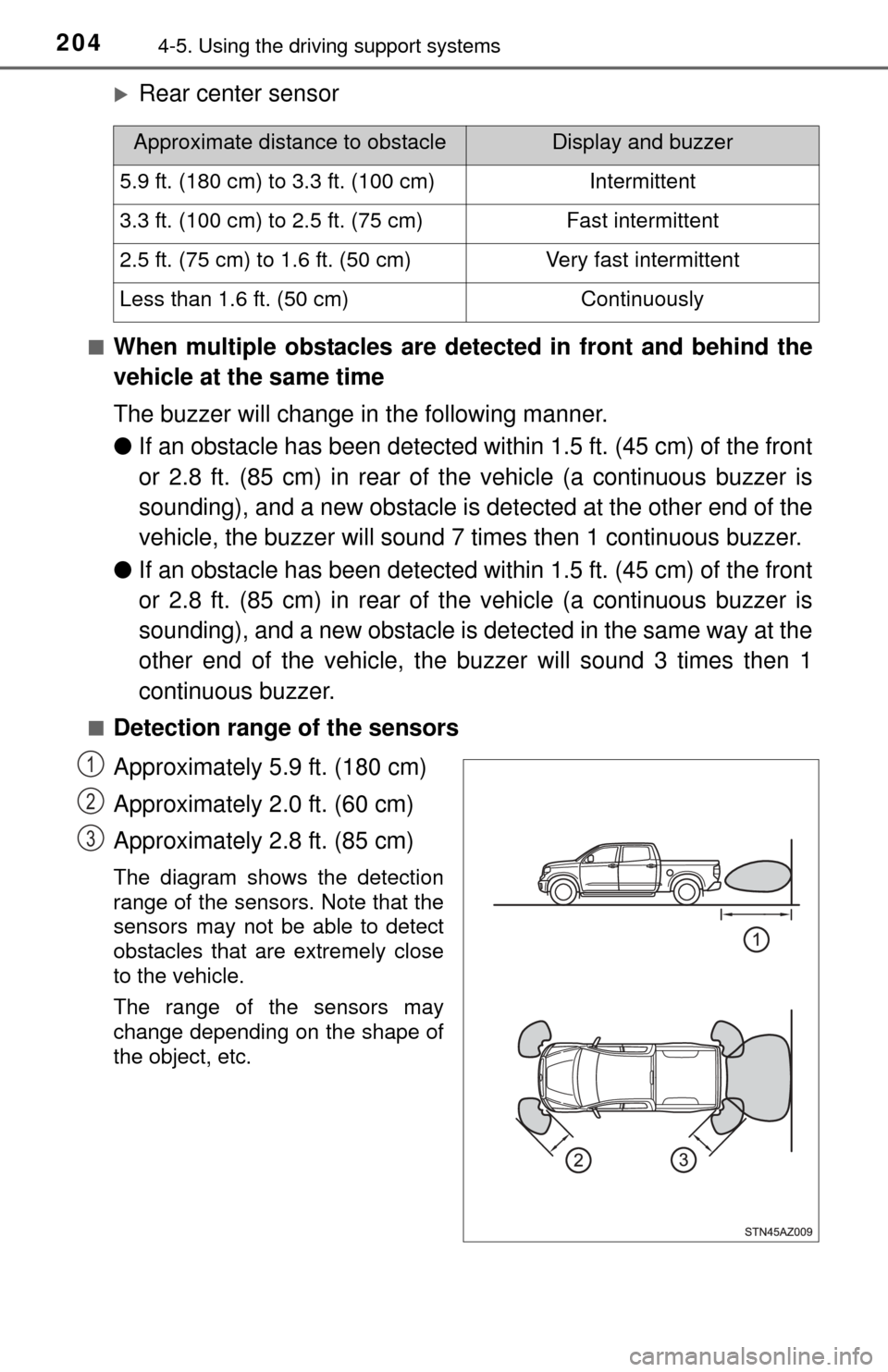
2044-5. Using the driving support systems
´üÁRear center sensor
ÔûáWhen multiple obstacles are de tected in front and behind the
vehicle at the same time
The buzzer will change in the following manner.
ÔùÅ If an obstacle has been detected within 1.5 ft. (45 cm) of the front
or 2.8 ft. (85 cm) in rear of the vehicle (a continuous buzzer is
sounding), and a new obstacle is de tected at the other end of the
vehicle, the buzzer will sound 7 times then 1 continuous buzzer.
ÔùÅ If an obstacle has been detected within 1.5 ft. (45 cm) of the front
or 2.8 ft. (85 cm) in rear of the vehicle (a continuous buzzer is
sounding), and a new obstacle is detected in the same way at the
other end of t he vehicle, the buzzer will sound 3 times then 1
continuous buzzer.
ÔûáDetection range of the sensors
Approximately 5.9 ft. (180 cm)
Approximately 2.0 ft. (60 cm)
Approximately 2.8 ft. (85 cm)
The diagram shows the detection
range of the sensors. Note that the
sensors may not be able to detect
obstacles that are extremely close
to the vehicle.
The range of the sensors may
change depending on the shape of
the object, etc.
Approximate distance to obstacleDisplay and buzzer
5.9 ft. (180 cm) to 3.3 ft. (100 cm)Intermittent
3.3 ft. (100 cm) to 2.5 ft. (75 cm)Fast intermittent
2.5 ft. (75 cm) to 1.6 ft. (50 cm)Very fast intermittent
Less than 1.6 ft. (50 cm)Continuously
1
2
3
Page 205 of 576

2054-5. Using the driving support systems
4
Driving
ÔûáThe intuitive parking assist can be operated when
ÔùÅFront corner sensors:
ÔÇó The engine switch is in the ÔÇ£ONÔÇØ position.
ÔÇó The shift lever is in R.
ÔÇó The shift lever is not in P or R and vehicle speed is less than about 6 mph
(10 km/h).
ÔùÅ Rear corner and rear center sensors:
ÔÇó The engine switch is in the ÔÇ£ONÔÇØ position.
ÔÇó The shift lever is in R.
Ôûá Sensor detection information
ÔùÅThe sensorÔÇÖs detection areas are limited to the areas around the vehicleÔÇÖs
front corner and rear bumpers.
ÔùÅ Certain vehicle conditions and the surrounding environment may affect the
ability of the sensor to correctly detect obstacles. Particular instances where
this may occur are listed below.
ÔÇó There is dirt, snow or ice on the sensor. (Wiping the sensors will resolve
this problem.)
ÔÇó The sensor is frozen. (Thawing the area will resolve this problem.)
ÔÇó The sensor is covered in any way.
ÔÇó The vehicle is leaning considerably to one side.
ÔÇó On an extremely bumpy road, on an incline, on gravel, or on grass.
ÔÇó The vicinity of the vehicle is noisy due to vehicle horns, motorcycle
engines, air brakes of large vehicles, or other loud noises producing ultra-
sonic waves.
ÔÇó There is another vehicle equipped with parking assist sensors in the
vicinity.
ÔÇó The sensor is coated with a sheet of spray or heavy rain.
ÔÇó The vehicle is equipped with a fender pole or radio antenna.
ÔÇó The bumper or sensor receives a strong impact.
ÔÇó The vehicle is approaching a tall or curved curb.
ÔÇó In harsh sunlight or intense cold weather.
ÔÇó The area directly under the bumpers is not detected.
ÔÇó If obstacles draw too close to the sensor.
ÔÇó A non-genuine Toyota suspension (lowered suspension, etc.) is installed.
ÔÇó People may not be detected if they are wearing certain types of clothing.
In addition to the examples above, there are instances in which, because of
their shape, signs and other objects may be judged by the sensor to be closer
than they are.
Page 206 of 576
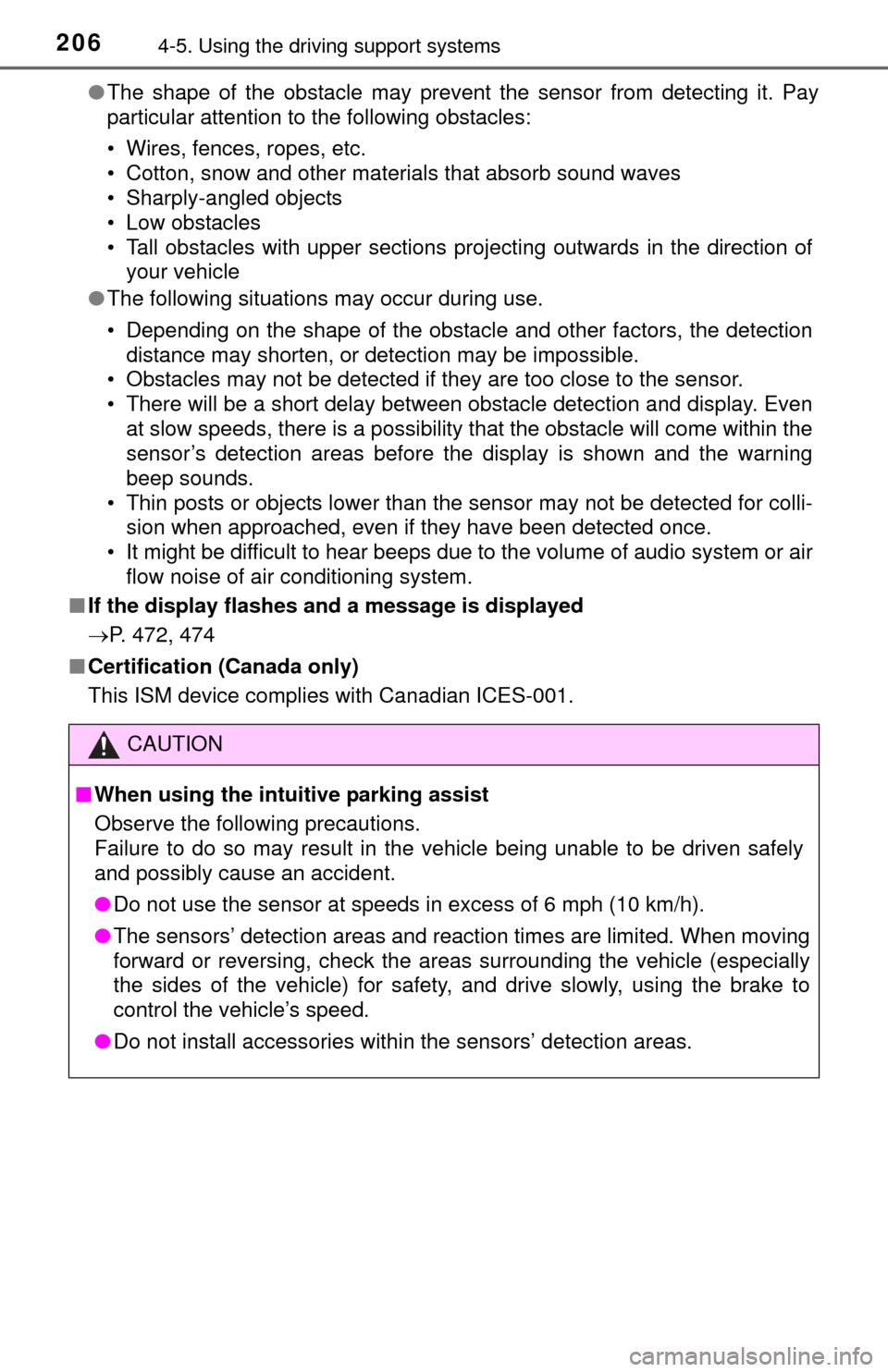
2064-5. Using the driving support systems
ÔùÅThe shape of the obstacle may prevent the sensor from detecting it. Pay
particular attention to the following obstacles:
ÔÇó Wires, fences, ropes, etc.
ÔÇó Cotton, snow and other materials that absorb sound waves
ÔÇó Sharply-angled objects
ÔÇó Low obstacles
ÔÇó Tall obstacles with upper sections projecting outwards in the direction of
your vehicle
ÔùÅ The following situations may occur during use.
ÔÇó Depending on the shape of the obstacle and other factors, the detection
distance may shorten, or detection may be impossible.
ÔÇó Obstacles may not be detected if they are too close to the sensor.
ÔÇó There will be a short delay between obstacle detection and display. Even at slow speeds, there is a possibility that the obstacle will come within the
sensorÔÇÖs detection areas before the display is shown and the warning
beep sounds.
ÔÇó Thin posts or objects lower than the sensor may not be detected for colli- sion when approached, even if they have been detected once.
ÔÇó It might be difficult to hear beeps due to the volume of audio system or air flow noise of air conditioning system.
Ôûá If the display flashes and a message is displayed
´é«P. 472, 474
Ôûá Certification (Canada only)
This ISM device complies with Canadian ICES-001.
CAUTION
ÔûáWhen using the intuitive parking assist
Observe the following precautions.
Failure to do so may result in the vehicle being unable to be driven safely
and possibly cause an accident.
ÔùÅ Do not use the sensor at speeds in excess of 6 mph (10 km/h).
ÔùÅ The sensorsÔÇÖ detection areas and reaction times are limited. When moving
forward or reversing, check the areas surrounding the vehicle (especially
the sides of the vehicle) for safety, and drive slowly, using the brake to
control the vehicleÔÇÖs speed.
ÔùÅ Do not install accessories within the sensorsÔÇÖ detection areas.
Page 207 of 576
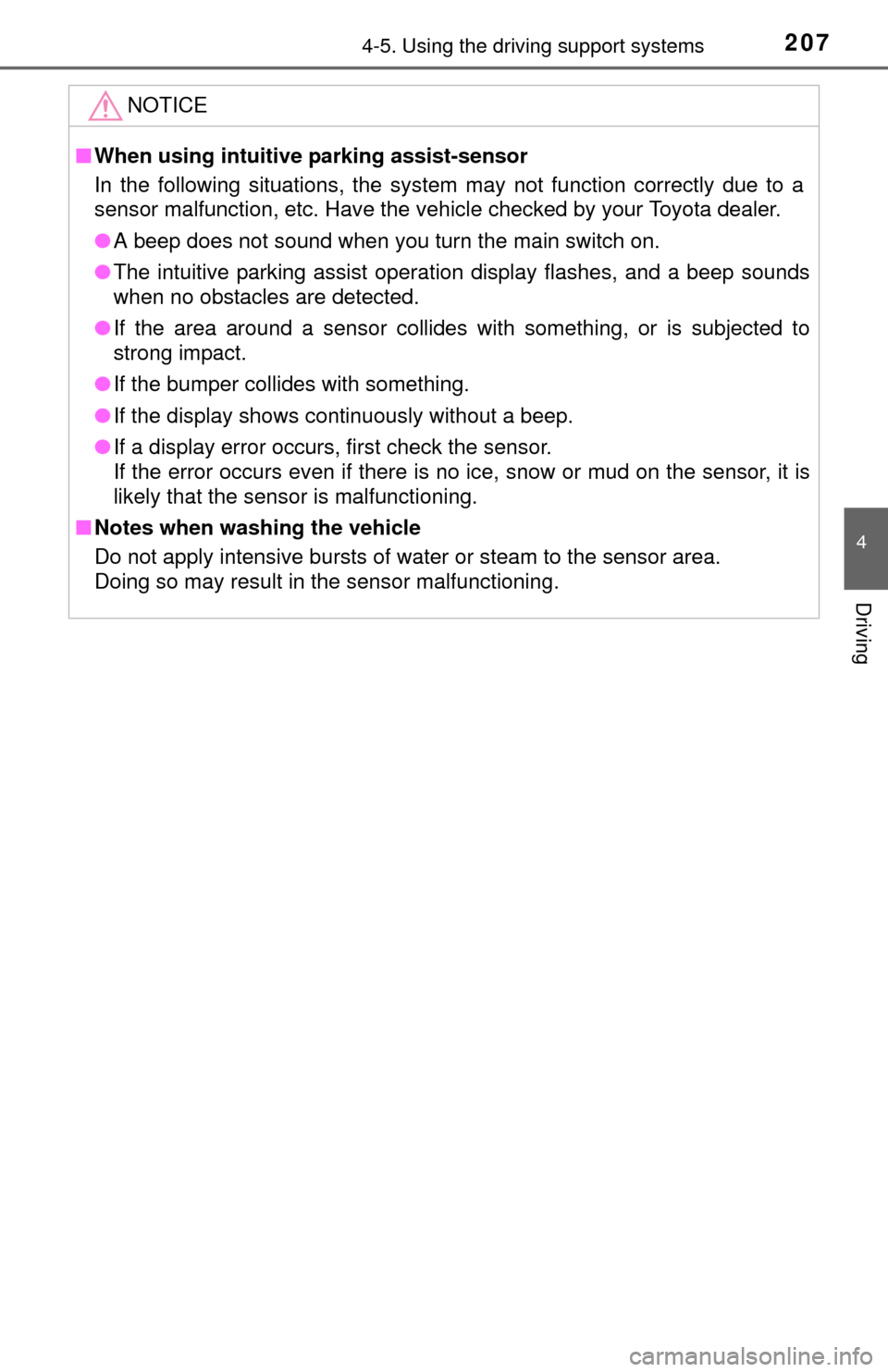
2074-5. Using the driving support systems
4
Driving
NOTICE
ÔûáWhen using intuitive parking assist-sensor
In the following situations, the system may not function correctly due t\
o a
sensor malfunction, etc. Have the vehicle checked by your Toyota dealer.
ÔùÅ A beep does not sound when you turn the main switch on.
ÔùÅ The intuitive parking assist operation display flashes, and a beep sounds
when no obstacles are detected.
ÔùÅ If the area around a sensor collides with something, or is subjected to
strong impact.
ÔùÅ If the bumper collides with something.
ÔùÅ If the display shows continuously without a beep.
ÔùÅ If a display error occurs, first check the sensor.
If the error occurs even if there is no ice, snow or mud on the sensor, it is
likely that the sensor is malfunctioning.
Ôûá Notes when washing the vehicle
Do not apply intensive bursts of water or steam to the sensor area.
Doing so may result in the sensor malfunctioning.
Page 208 of 576
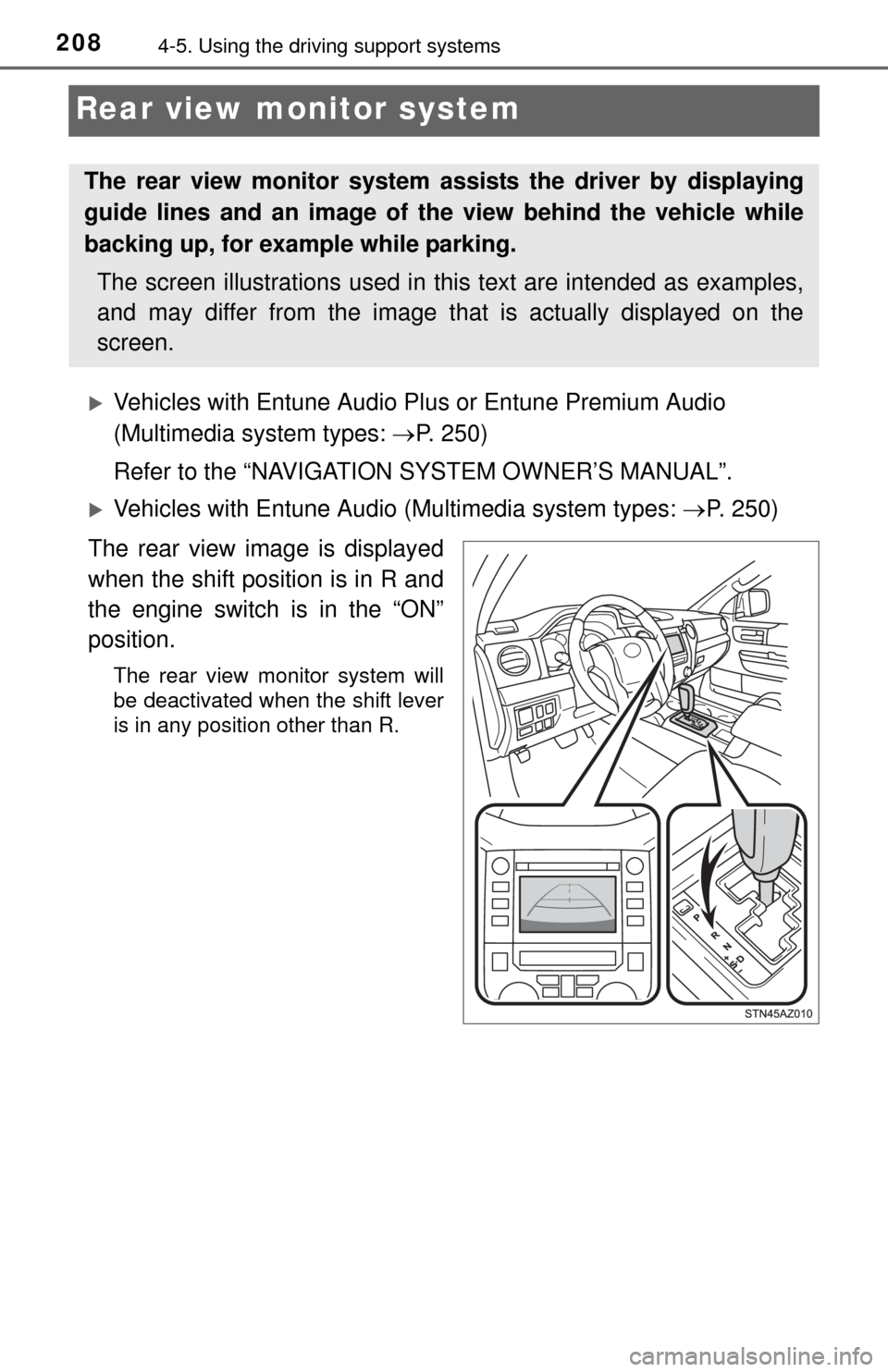
2084-5. Using the driving support systems
Rear view monitor system
´üÁVehicles with Entune Audio Pl us or Entune Premium Audio
(Multimedia system types: ´é«P. 250)
Refer to the ÔÇ£NAVIGATION SYSTEM OWNERÔÇÖS MANUALÔÇØ.
´üÁVehicles with Entune Audio (Multimedia system types: ´é«P. 250)
The rear view image is displayed
when the shift position is in R and
the engine switch is in the ÔÇ£ONÔÇØ
position.
The rear view monitor system will
be deactivated when the shift lever
is in any position other than R.
The rear view monitor system as sists the driver by displaying
guide lines and an image of the view behind the vehicle while
backing up, for example while parking.
The screen illustrations used in this text are intended as examples,
and may differ from the image that is actually displayed on the
screen.
Page 209 of 576
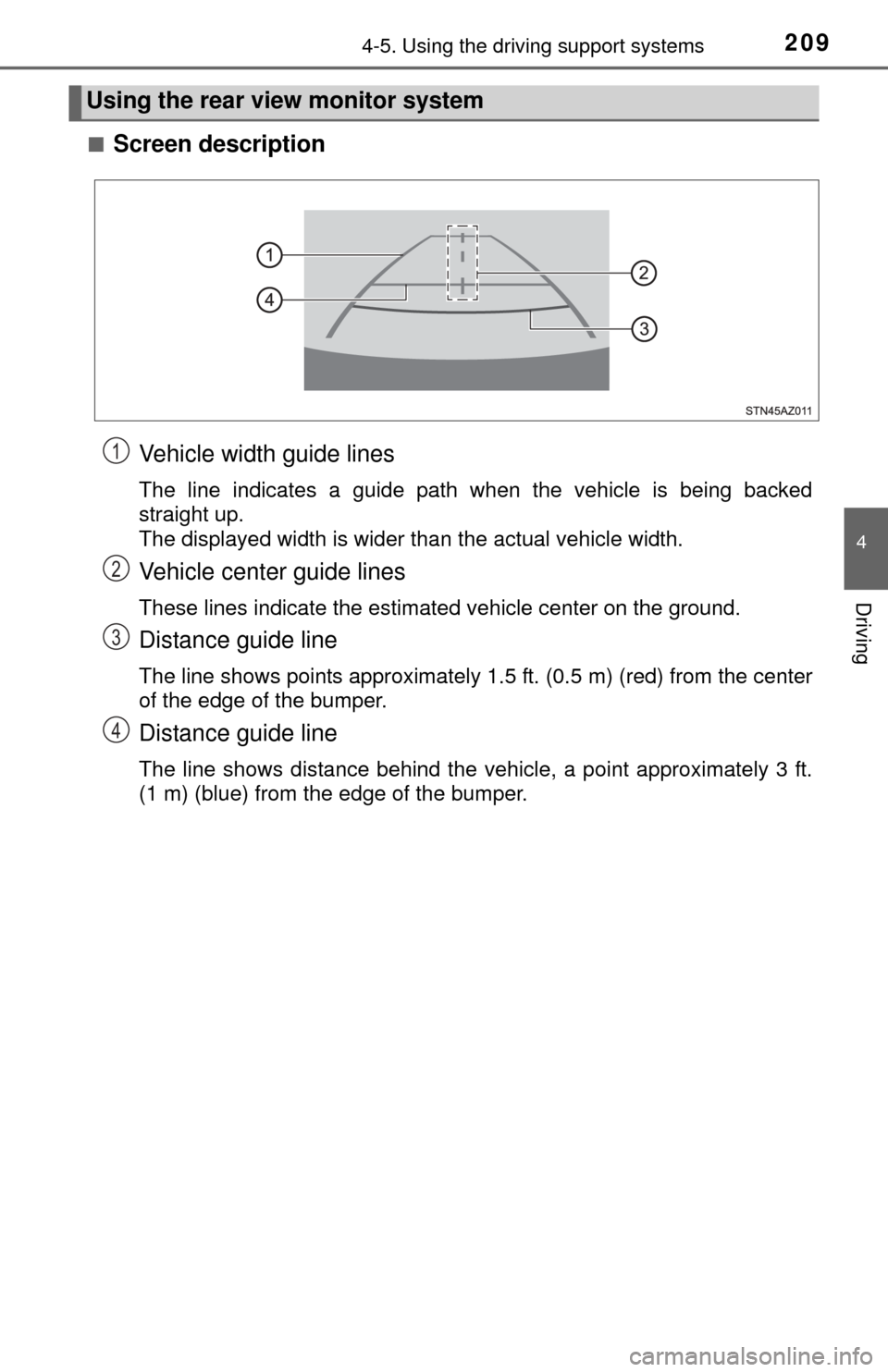
2094-5. Using the driving support systems
4
Driving
ÔûáScreen descriptionVehicle width guide lines
The line indicates a guide path when the vehicle is being backed
straight up.
The displayed width is wider than the actual vehicle width.
Vehicle center guide lines
These lines indicate the estimated vehicle center on the ground.
Distance guide line
The line shows points approximately 1.5 ft. (0.5 m) (red) from the center
of the edge of the bumper.
Distance guide line
The line shows distance behind the vehicle, a point approximately 3 ft.
(1 m) (blue) from the edge of the bumper.
Using the rear view monitor system
1
2
3
4
Page 210 of 576
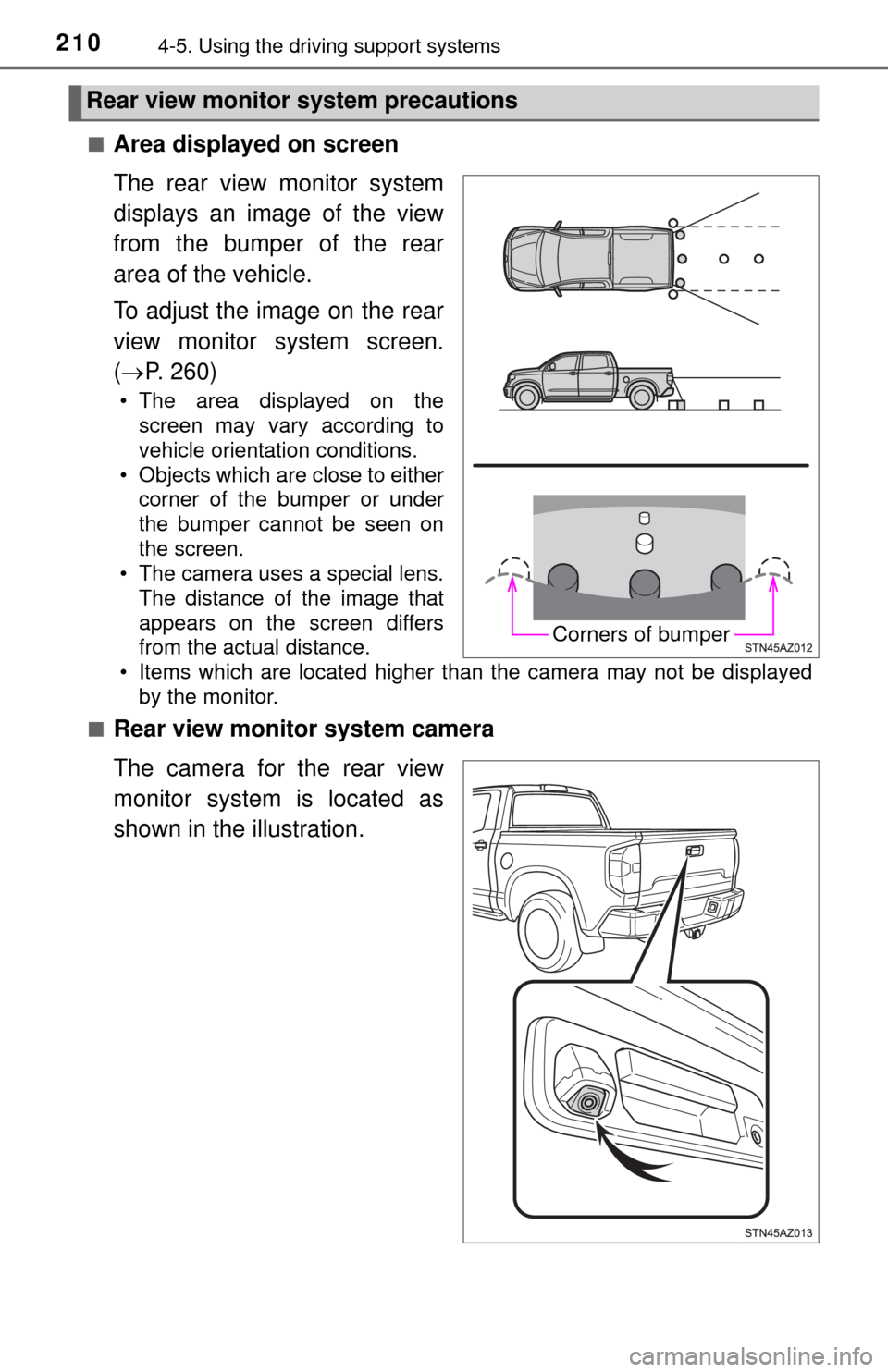
2104-5. Using the driving support systems
ÔûáArea displayed on screen
The rear view monitor system
displays an image of the view
from the bumper of the rear
area of the vehicle.
To adjust the image on the rear
view monitor system screen.
(´é« P. 260)
ÔÇó The area displayed on the
screen may vary according to
vehicle orientation conditions.
ÔÇó Objects which are close to either corner of the bumper or under
the bumper cannot be seen on
the screen.
ÔÇó The camera uses a special lens. The distance of the image that
appears on the screen differs
from the actual distance.
ÔÇó Items which are located higher than the camera may not be displayed
by the monitor.
Ôûá
Rear view monitor system camera
The camera for the rear view
monitor system is located as
shown in the illustration.
Rear view monitor system precautions
Corners of bumper